Ask a question from expert
Hofstede’s cultural dimension of Singapore pdf
35 Pages6076 Words226 Views
Added on 2021-10-11
Hofstede’s cultural dimension of Singapore pdf
Added on 2021-10-11
BookmarkShareRelated Documents
[Year]
I | P a g e
Individual Assignment 1
Program / Intake BSc20 HRM FT
Pathway HRM
Module Title Cross Cultural Management
Lecturer/Tutor Jacob Eisenberg & Richard Tan
Student Name Zhang YueqiStudent Number 13206951Number of WordsPart 1& 2—1361 Part3—
2014
I | P a g e
Individual Assignment 1
Program / Intake BSc20 HRM FT
Pathway HRM
Module Title Cross Cultural Management
Lecturer/Tutor Jacob Eisenberg & Richard Tan
Student Name Zhang YueqiStudent Number 13206951Number of WordsPart 1& 2—1361 Part3—
2014

Individual Assignment 1
II | P a g e
II | P a g e
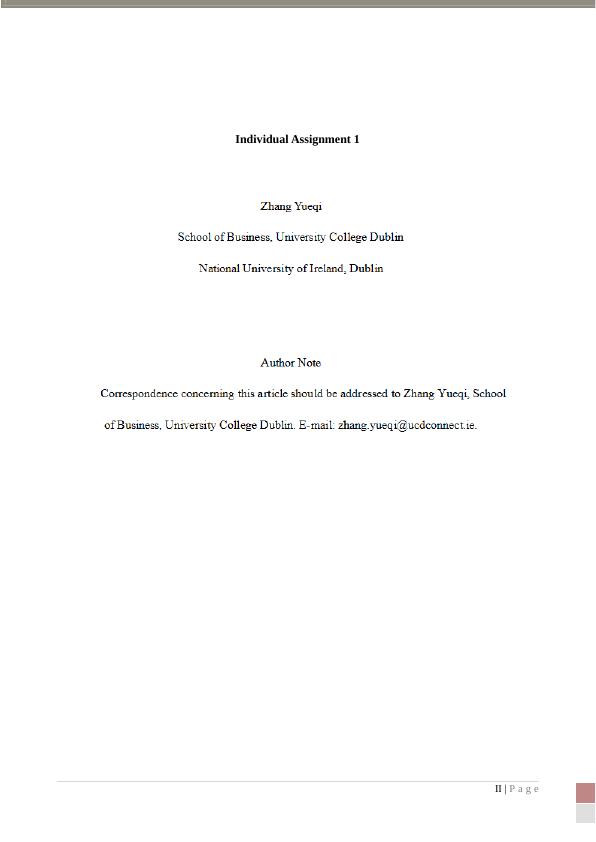
TABLE OF CONTENTS
Page
Part 1 1
Brief Summary..................................................................... 1
Responds to the article............................................................ 1
Part 2 4
First Impression of Singapore.................................................... 4
Experience in Singapore........................................................... 4
Reflective Thinking................................................................. 4
Part 3 8
Step one: self-awareness.......................................................... 8
Enculturation.................................................................. 8
Step two: cross-cultural understanding....................................... 8
Acculturation.................................................................. 8
American culture score from others...................................... 9
Comparison.................................................................... 12
Step three: adapt professional skills............................................ 14
List of References .................................................................. 17
Appendix ............................................................................ 22
LIST OF FIGURES
Page
Figure 1 Hofstede’s cultural dimension of Singapore ...................... 2
Figure 2 The competing values framework .................................. 5
Figure 3 Current to preferred future culture profiles change .............. 6
Figure 4 Own cultural profile .................................................. 8
Figure 5 Hofstede’s cultural dimension scored on the United States ..... 10
Figure 6 Own profile vs. U.S profile .......................................... 12
III | P a g e
Page
Part 1 1
Brief Summary..................................................................... 1
Responds to the article............................................................ 1
Part 2 4
First Impression of Singapore.................................................... 4
Experience in Singapore........................................................... 4
Reflective Thinking................................................................. 4
Part 3 8
Step one: self-awareness.......................................................... 8
Enculturation.................................................................. 8
Step two: cross-cultural understanding....................................... 8
Acculturation.................................................................. 8
American culture score from others...................................... 9
Comparison.................................................................... 12
Step three: adapt professional skills............................................ 14
List of References .................................................................. 17
Appendix ............................................................................ 22
LIST OF FIGURES
Page
Figure 1 Hofstede’s cultural dimension of Singapore ...................... 2
Figure 2 The competing values framework .................................. 5
Figure 3 Current to preferred future culture profiles change .............. 6
Figure 4 Own cultural profile .................................................. 8
Figure 5 Hofstede’s cultural dimension scored on the United States ..... 10
Figure 6 Own profile vs. U.S profile .......................................... 12
III | P a g e
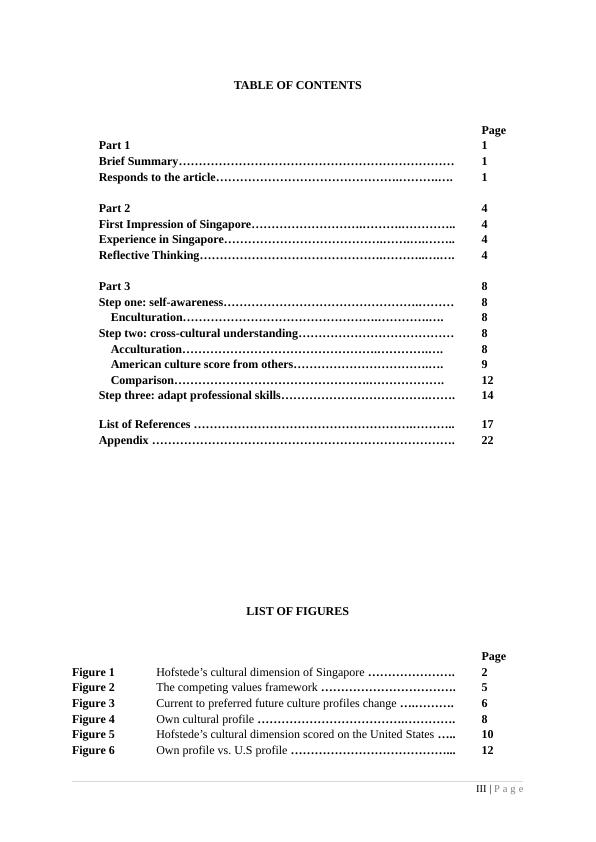
LIST OF TABLES
Page
Table 1 My cultural profile score and other score of the United States.. 9
Table 2 High/Low context by culture........................................ 11
IV | P a g e
Page
Table 1 My cultural profile score and other score of the United States.. 9
Table 2 High/Low context by culture........................................ 11
IV | P a g e
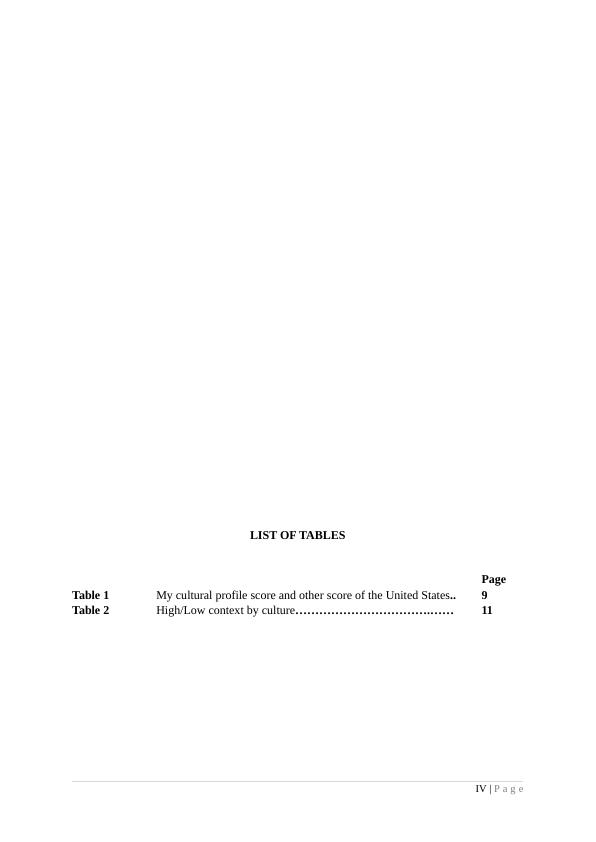
Part 1
Brief Summary
The analysis of news, From emotions to shared values (Appendix1), talks about the
dominance of negative public emotions associated with the release of the Population White
Paper, the riot at Little India and moral issues with non-profit organizations. The author also
highlights the opportunities for policymakers when the strong negative emotions were
experienced and expressed and leaded to policy discussions and public debates. Being
concerned about the development of country and progress of society, author suggests three
shared values – ‘integrity, fairness and social harmony’, to address public emotion in different
contexts; he also provides three guiding principles – ‘rule of law, accountability and people-
centricity’, to evaluate public action and policy.
Responds to the article
After read this article, first of all, the author’s perspective about emotion is attractive and
persuasive. Base on one of Trompenaars’ seven dimensions of culture — neutral versus
affective relationships (Browaeys and Price, 2011); Singapore is ranked one of the
emotionless countries where people act stoically and maintain composure. Under this high
neutral culture, the strong negative emotion had observably expressed by public, which means
that the issues were really critical. In addition, the expression of negative emotion has
revealed Singapore’s cultural dimension in emotion context has changed from the least
emotional turns to less emotional (Teng and Lim, 2013), although the change is slow and in
small amplitude.
Secondly, fairness is a good expectation but it is probably idealistic to achieve consensus
on what is essential to be actualized and how to do so. Based on Hofstede’s culture
dimension, Singapore scores 74 for power distance as shown in Figure 1 (The Hofstede
Centre, 2014). As a consequence, individuals and groups can readily accept role and
interpersonal inequality and its institutionalization as high in power distance (Chow et al.
2001). Wang and Nayir’s (2001) research also demonstrates that high power distance value
would weaken the positive link between procedural justice and decision-making behaviors.
1 | P a g e
Brief Summary
The analysis of news, From emotions to shared values (Appendix1), talks about the
dominance of negative public emotions associated with the release of the Population White
Paper, the riot at Little India and moral issues with non-profit organizations. The author also
highlights the opportunities for policymakers when the strong negative emotions were
experienced and expressed and leaded to policy discussions and public debates. Being
concerned about the development of country and progress of society, author suggests three
shared values – ‘integrity, fairness and social harmony’, to address public emotion in different
contexts; he also provides three guiding principles – ‘rule of law, accountability and people-
centricity’, to evaluate public action and policy.
Responds to the article
After read this article, first of all, the author’s perspective about emotion is attractive and
persuasive. Base on one of Trompenaars’ seven dimensions of culture — neutral versus
affective relationships (Browaeys and Price, 2011); Singapore is ranked one of the
emotionless countries where people act stoically and maintain composure. Under this high
neutral culture, the strong negative emotion had observably expressed by public, which means
that the issues were really critical. In addition, the expression of negative emotion has
revealed Singapore’s cultural dimension in emotion context has changed from the least
emotional turns to less emotional (Teng and Lim, 2013), although the change is slow and in
small amplitude.
Secondly, fairness is a good expectation but it is probably idealistic to achieve consensus
on what is essential to be actualized and how to do so. Based on Hofstede’s culture
dimension, Singapore scores 74 for power distance as shown in Figure 1 (The Hofstede
Centre, 2014). As a consequence, individuals and groups can readily accept role and
interpersonal inequality and its institutionalization as high in power distance (Chow et al.
2001). Wang and Nayir’s (2001) research also demonstrates that high power distance value
would weaken the positive link between procedural justice and decision-making behaviors.
1 | P a g e
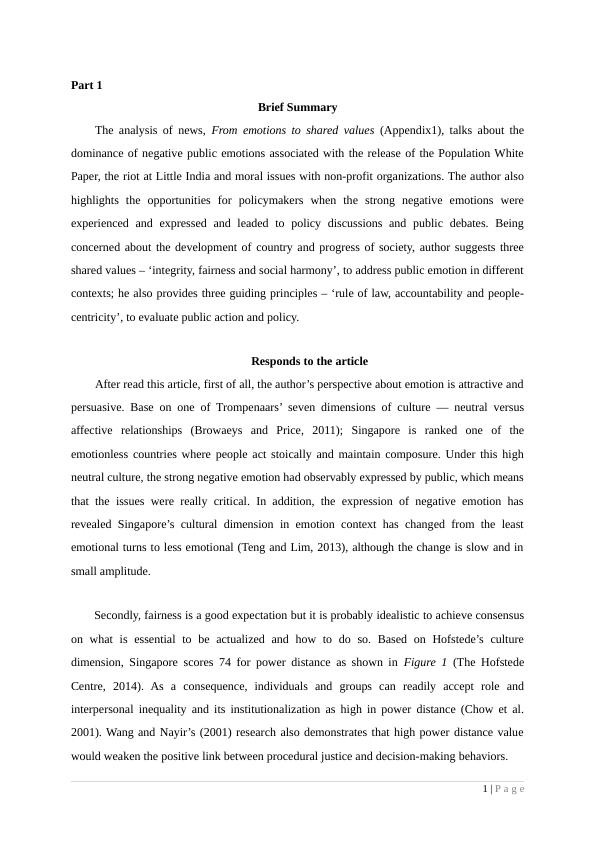
Figure 1: Hofstede’s cultural dimension of Singapore.
Source: The Hofstede Centre, 2014.
Furthermore, Chinese is the majority at 74% of the resident population in Singapore as
shown in Appendix 2, thus the Confucian background is rooted in Singapore’s culture (Khan,
2001). Stability of society is one of the key principles of Confucian teaching and it is built on
the basis of unequal relationships between people such as ruler – subject, father – son, and
older brother – younger brother; those relationships are based on mutual and complementary
obligations. Hence, Singapore culture promotes loyalty, respect for authority and place great
value on reciprocity, and interdependence in honoring relationships due to high in Confucian
values (Chan, 2008).
Thirdly, the proposal of social harmony as shared value is essential and appropriate, it
can help to alleviate the negative public emotions and enhance social cohesion and
integration. As a multicultural society, Singapore has achieved relatively high level of social
harmony (Ong, 2010), this can be supported by Hofstede’s cultural dimension of Masculinity
value which scores 48 as shown in Figure 1 (The Hofstede Centre, 2014). Singapore is at
2 | P a g e
Source: The Hofstede Centre, 2014.
Furthermore, Chinese is the majority at 74% of the resident population in Singapore as
shown in Appendix 2, thus the Confucian background is rooted in Singapore’s culture (Khan,
2001). Stability of society is one of the key principles of Confucian teaching and it is built on
the basis of unequal relationships between people such as ruler – subject, father – son, and
older brother – younger brother; those relationships are based on mutual and complementary
obligations. Hence, Singapore culture promotes loyalty, respect for authority and place great
value on reciprocity, and interdependence in honoring relationships due to high in Confucian
values (Chan, 2008).
Thirdly, the proposal of social harmony as shared value is essential and appropriate, it
can help to alleviate the negative public emotions and enhance social cohesion and
integration. As a multicultural society, Singapore has achieved relatively high level of social
harmony (Ong, 2010), this can be supported by Hofstede’s cultural dimension of Masculinity
value which scores 48 as shown in Figure 1 (The Hofstede Centre, 2014). Singapore is at
2 | P a g e
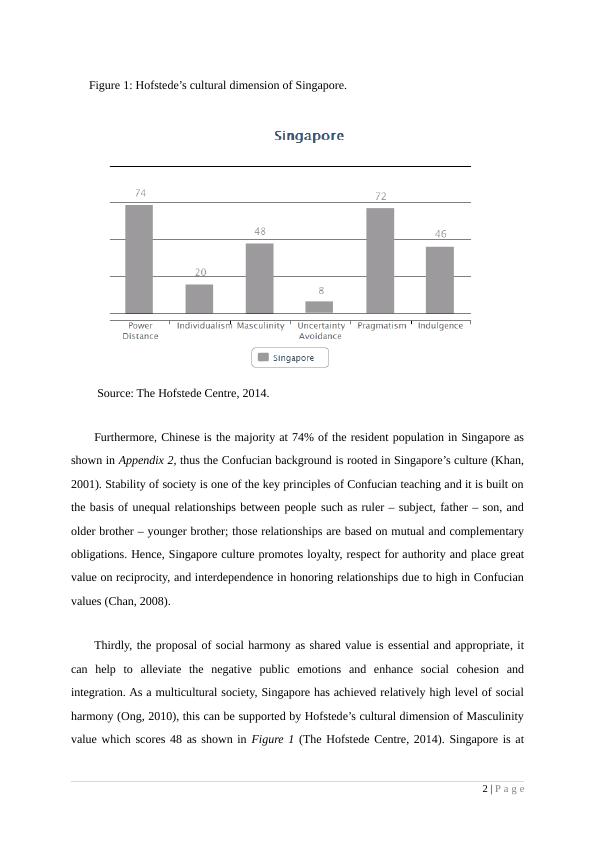
middle level of scale but towards to the feminism side, it means the softer aspects of culture
such as caring for others, consensus, sympathy for the underdog are valued and encouraged;
but competition, achievement and success are also important. This feminism is also reflected
in the government’s defined in one of the shared values – ‘community support and respect for
the individual’.
Culture is multidimensional, some complex factors such as acculturation factor may
shape the Confucian influence, but according to Lu and Shih’s research (1997), certain
Confucian values are slow to change, interpersonal relationships (family harmony) for
instance; so family and society harmony are still the central concepts of Confucianism that
deeply rooted in Singapore (Tan, 2004).
Lastly, the ‘positive outcome’ derives from ‘negative emotions’ are really positive? If
government responded such citizen emotion or populist pressure, it might provide the basis
for “reluctant collectivism” (Lindert, 1996); as consumers, citizens seek higher government
expenditure such as social security and welfare, but as taxpayers, they might be unwilling to
finance the provision of those public services. But perhaps, the remarkable degree of social
conformism in Singapore could help government overcome such populist pressures.
3 | P a g e
such as caring for others, consensus, sympathy for the underdog are valued and encouraged;
but competition, achievement and success are also important. This feminism is also reflected
in the government’s defined in one of the shared values – ‘community support and respect for
the individual’.
Culture is multidimensional, some complex factors such as acculturation factor may
shape the Confucian influence, but according to Lu and Shih’s research (1997), certain
Confucian values are slow to change, interpersonal relationships (family harmony) for
instance; so family and society harmony are still the central concepts of Confucianism that
deeply rooted in Singapore (Tan, 2004).
Lastly, the ‘positive outcome’ derives from ‘negative emotions’ are really positive? If
government responded such citizen emotion or populist pressure, it might provide the basis
for “reluctant collectivism” (Lindert, 1996); as consumers, citizens seek higher government
expenditure such as social security and welfare, but as taxpayers, they might be unwilling to
finance the provision of those public services. But perhaps, the remarkable degree of social
conformism in Singapore could help government overcome such populist pressures.
3 | P a g e
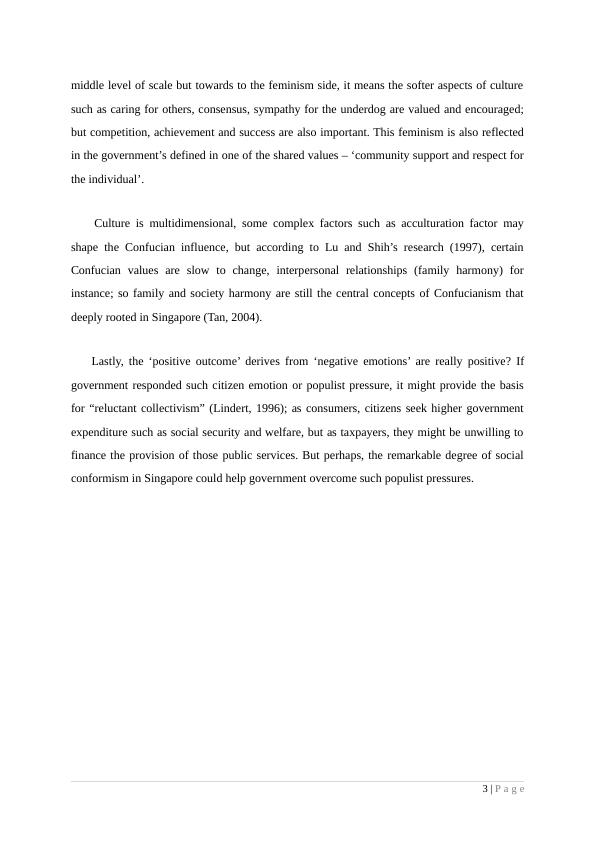
Part 2
First Impression of Singapore
There is no other unique place in the world that blends East and West, conciliates
tradition and modernity, quite like Singapore. Those fashioned skyscrapers in CBD area mark
Singapore as an international financial center; and those old colonial buildings depict the
history of Singapore. English, Mandarin, Malay and Tamil are official languages. ‘Singlish’, a
colourful and unique Singaporean English that lives by the rules of Chinese grammar and
hybrid words from Malay, Hokkien, Cantonese and India dialects. The rich cultural diversity
is also reflected in many aspects like food, festivals and faith. Those multicultural artifacts
constitute the first level of Singapore culture, and its society’s personality.
Experience in Singapore
I worked as HR Administrator at a construction company in Singapore (Appendix 3). The
company provides individual offices to middle and top management, especially the largest
room with upscale furnishings was for the boss. Thus, position level can be easily identified
from the office size. The subordinates were assigned to work and told what to do, and the
centralized decision-making resulted subordinates would not participate in any decision-
making process; and the power is concentrated in the hands of a few high-ranking managers.
Information flow was in top-down direction. These evidences reveal that the company is
bureaucratic and highly hierarchical as high power distance culture value.
During my service period, I have noticed the high turnover rate in the company
especially for foreign employees. This gives me a hint that the company does not value
productivity and competitive advantages as they failed to acquire and foster talented human
resources and paid less attention to organizational environment. The evidences are such as no
salary increment after probation period and no annual salary increment system to fulfill
employee's expectancy.
Reflective Thinking
4 | P a g e
First Impression of Singapore
There is no other unique place in the world that blends East and West, conciliates
tradition and modernity, quite like Singapore. Those fashioned skyscrapers in CBD area mark
Singapore as an international financial center; and those old colonial buildings depict the
history of Singapore. English, Mandarin, Malay and Tamil are official languages. ‘Singlish’, a
colourful and unique Singaporean English that lives by the rules of Chinese grammar and
hybrid words from Malay, Hokkien, Cantonese and India dialects. The rich cultural diversity
is also reflected in many aspects like food, festivals and faith. Those multicultural artifacts
constitute the first level of Singapore culture, and its society’s personality.
Experience in Singapore
I worked as HR Administrator at a construction company in Singapore (Appendix 3). The
company provides individual offices to middle and top management, especially the largest
room with upscale furnishings was for the boss. Thus, position level can be easily identified
from the office size. The subordinates were assigned to work and told what to do, and the
centralized decision-making resulted subordinates would not participate in any decision-
making process; and the power is concentrated in the hands of a few high-ranking managers.
Information flow was in top-down direction. These evidences reveal that the company is
bureaucratic and highly hierarchical as high power distance culture value.
During my service period, I have noticed the high turnover rate in the company
especially for foreign employees. This gives me a hint that the company does not value
productivity and competitive advantages as they failed to acquire and foster talented human
resources and paid less attention to organizational environment. The evidences are such as no
salary increment after probation period and no annual salary increment system to fulfill
employee's expectancy.
Reflective Thinking
4 | P a g e
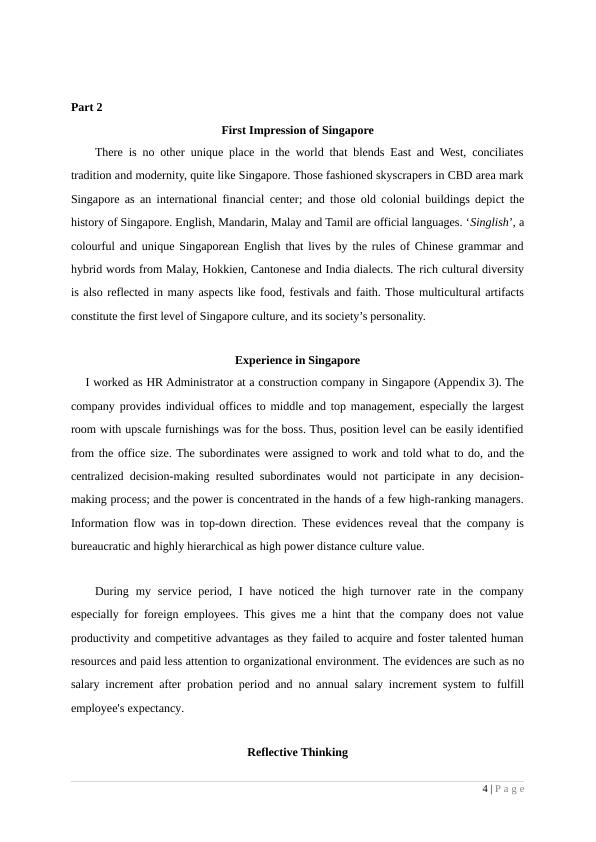
End of preview
Want to access all the pages? Upload your documents or become a member.
Related Documents
Cross Cultural Management: Understanding Cultural Differences in Canada and South Africalg...
|13
|3432
|423
Cross-Cultural and Global Management in Hospitality Assignmentlg...
|16
|4645
|36